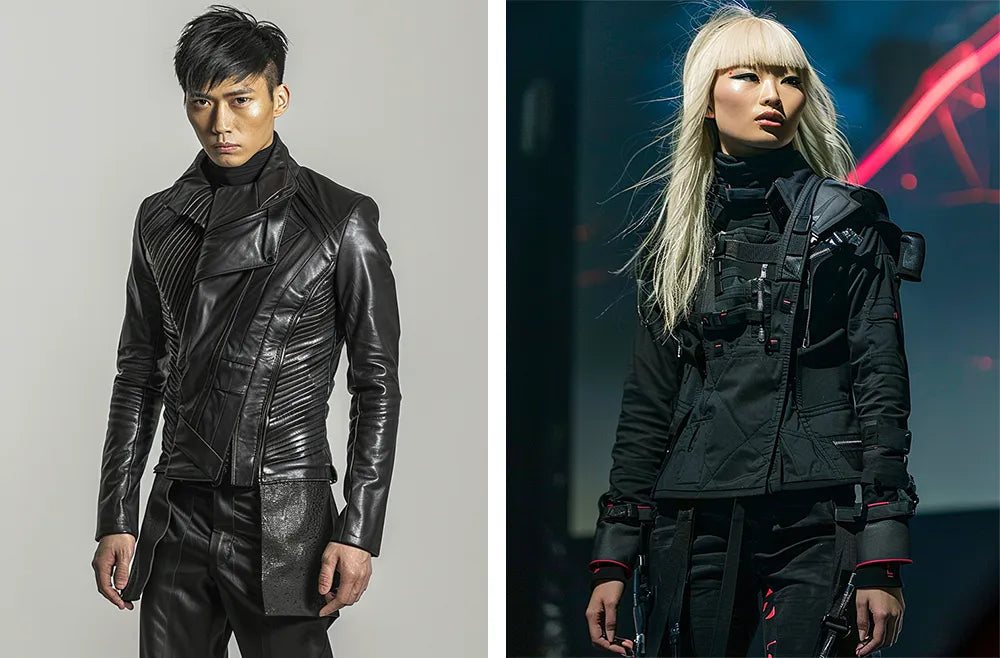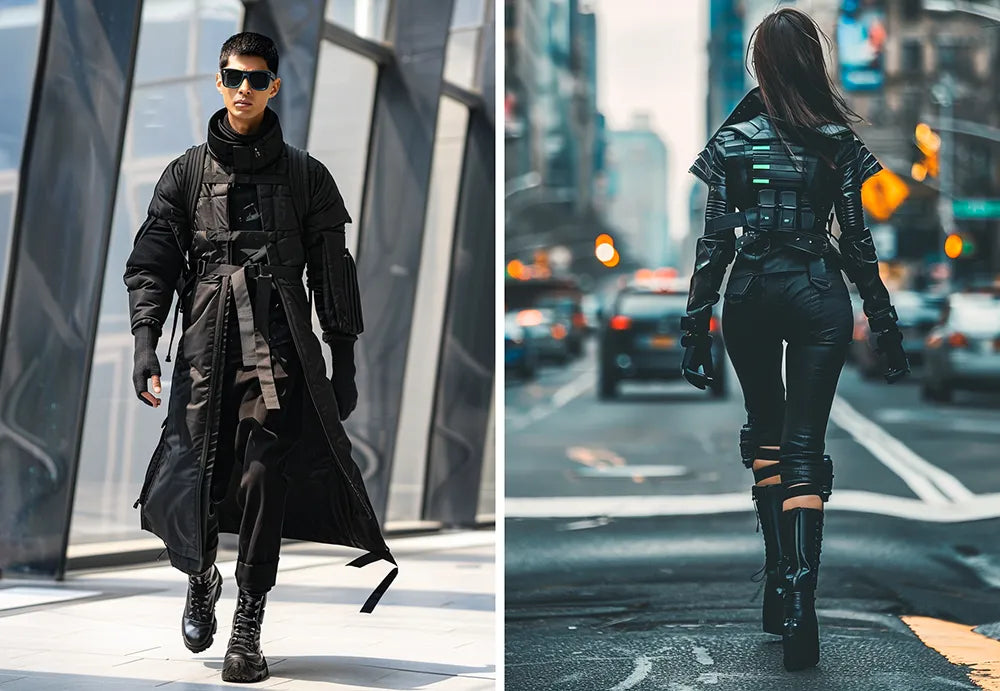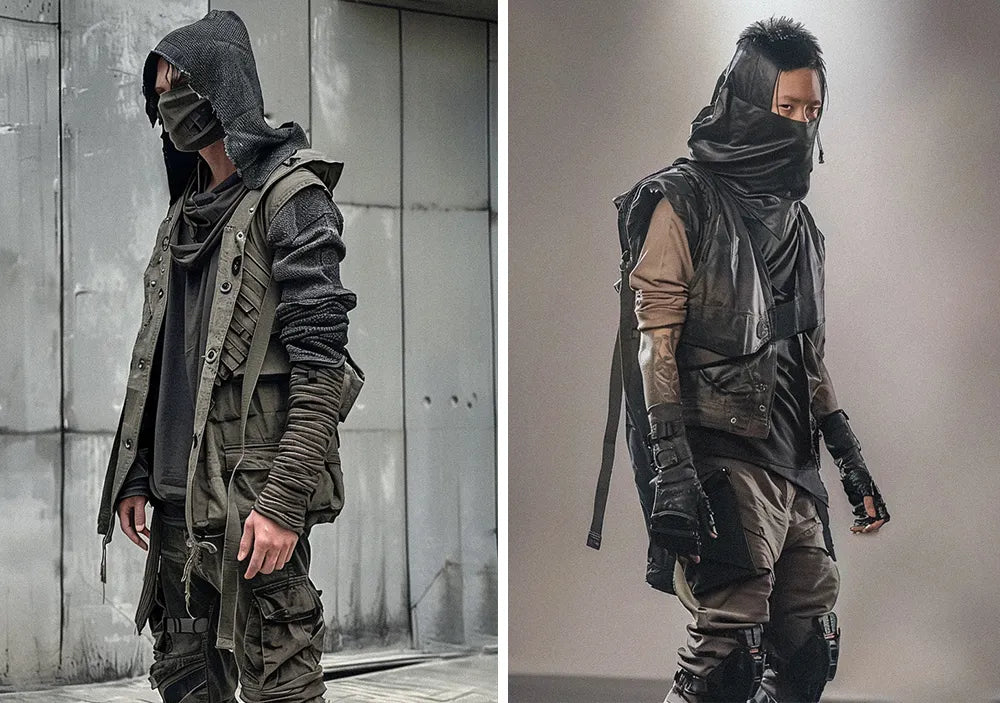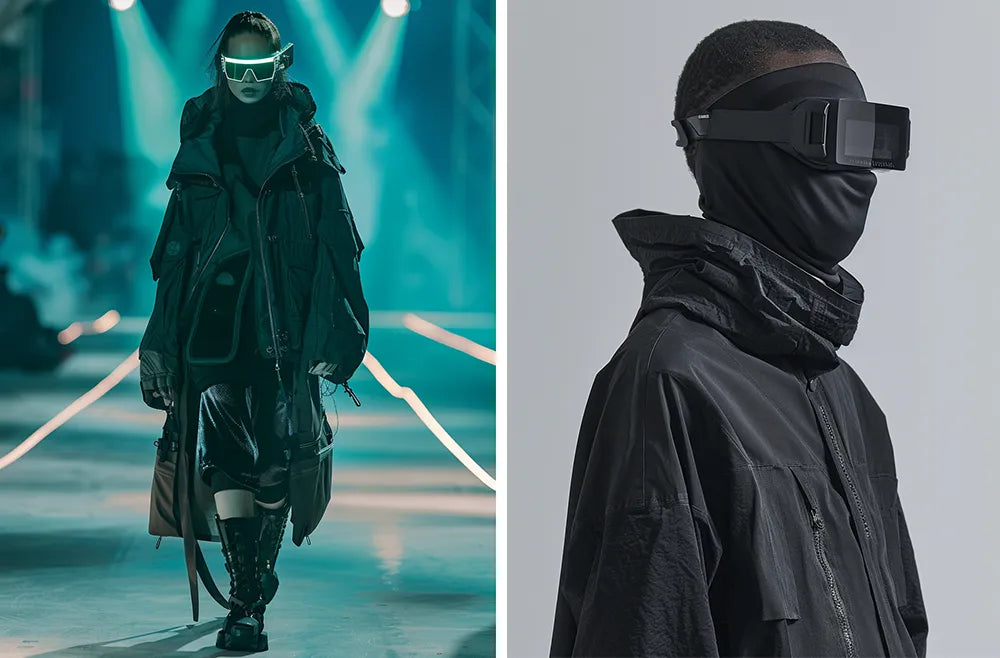
What is dystopian fashion?
Exploring the Rise of Dystopian Fashion

Dystopian clothes has gone from the catwalk and is now spilling onto the streets. It's gritty, utilitarian—with a whiff of something otherworldly. With the world facing new waves of challenges under the catastrophic forces of the environmental crisis and the technological upheaval, dystopian aesthetics have become a calling card for these complex narratives.
This is where enhancements in dystopian-aesthetized fashion go beyond mere trend, answering to our times and merging function with a unique edgy appeal.
Navigating the World of Dystopian Fashion

Now, we are going to navigate this multifaceted world of dystopian fashion. We will try to put into words what defines dystopian style, its origin, and some key characteristics.
More than that, we are going to proceed from how it reached mass productions of both high fashion and streetwear by influencing media. We are going to start from what the durability and functionality of the garments say out loud to the groundbreaking designs making way for this style.
We are also going to consider some sub-styles, of which cyberpunk and warcore are related, and the philosophy behind them.
By the end of this piece, you will have a long explanation of why dystopian fashion is in and, more than ever, how you can be a part of it.
Origins of Dystopian Fashion

Dystopian fashion draws from the lush tapestry of post-apocalyptic stories splattered across literature, cinema, and various other diffusion-based forms of media.
To elaborate, the view of a dystopian society—a world in ruin, humanity trying to survive amidst chaos—is a long one: fascinating, and at the same time, horrifying. Classic literary works, such as George Orwell's 1984 and Aldous Huxley's Brave New World, introduced readers to bleak futures governed by authoritarian regimes and their role in controlling the respective technological inundations.
Not only did these dystopian themes help in shaping thought processes in society, but they also laid a great dividend on matters of visual aesthetics.
Cinema Influence
Cinema helped cast these ideas into the heads of pop culture. For example, the movie Mad Max showing a lawless, desolate wasteland and Blade Runner, which showed a future that's neon-lit, cyberpunk, helped seal the feel of dystopian fashion in the minds.
These films received their characters in rugged, utilitarian clothing meant for survival, blending functionality with a worn-in style that the audiences resonated with.
Costumes from these movies often explored distressed fabrics, asymmetry, and tactical gear, setting a visual language that would then go on to heavily inform fashion designers from then on.
Key Characteristics of Dystopian Fashion

The key elements of dystopian fashion are deeply rooted in the thematic essence of survival and rebellion. The very essence of dystopian fashion can be imagined in the form of practicality and resilience, which is observed through the following characteristics:
Utilitarian Design
The most important facet of dystopian fashion is the practice of clothes that are worn which provide multiple purposes. This could range from a lot of pockets to detachable elements and sturdy pieces, which present materials made for really tough conditions.
Rugged Aesthetics

The scruffy and worn-out look surely reflects a world which has seen better days. This is typically realized in fabrics that are distressed, raw-edged, and with a general rough-hewn appearance.
Distressed Fabrics
Textiles are usually treated and manipulated to look ancient and battle-worn, thus giving the clothes added texture and a sense of history and toughness. This can go from faded denim and ripped leather to frayed cotton and patched-up synthetics.
Tactical Elements

Dystopian fashion draws heavily from military and survivalist gear and adds several tactical elements, including harnesses, belts, and protective gear. The harnesses are not just there for show; they are also functional.
Asymmetry and Deconstruction
Asymmetrical cuts and deconstructed designs are predominant, showing a divergence from the conventional fashion rules and a shift toward a more rebellious, individualistic style.
Cultural Significance of Dystopian Fashion

Dystopian fashion is not a matter of aesthetic style but represents anxiety in society and acts as a buzzing comment on current events. The rise in popularity of dystopian fashion has closely paralleled increased concern over environmental degradation, technological overreach, and political instability.
The themes of survival, resilience, and rebellion come into sharp focus and are reflected in the medium of dystopian fashion as societies teeter precariously on the brink of uncertainty.
Survival and Sustainability
In its heart, dystopian fashion is about survival. The attention is to durable and practical items that say one will not be able to live in a world where resources are scarce and can only afford decoration.
This is very much a real concern in the present age when considering environmental sustainability and adapting to environments on a rapidly changing planet. As overt as it may sound, dystopian fashion is a statement of rebellion.
Not much in it says couture beyond the inspiration of rampant deconstruction of the human genre and the use of asymmetry.
Resilience
Dystopian fashion, in its beaten, well-worn style, speaks volumes of resilience and a way to weather misfortune. Thus, it is a statement of culture, by which people express their strength in this changing environment, where it is wished for people to very visually show this as one of the major attributes of life at all instances.
Cultural Statement
Embracing dystopian aesthetics with fashion is also very much a statement on the part of culture. When a person wears clothing inspired by the themes that center around it, they make a statement to themselves about their awareness of and participation in the situations around them.
It speaks of one's visual stand on the issue of survival, resistance, and resilience in a world that, for the most part, keeps feeling rather dystopian.
Influences from Media on Dystopian Fashion

Movies
Movies have significantly contributed to creating a visual aesthetic for dystopian fashion. Iconic movies such as "Blade Runner," "Mad Max," and "The Matrix" have not only set the visual language for dystopian worlds but also influenced real-world fashion trends.
Blade Runner (1982)
Directed by Ridley Scott, the father of most dystopian classics, "Blade Runner" established a groundbreaking visual style. The neon-lit, rain-soaked streets and the futuristic-retro mix became a template for dystopian fashion.
Costume designers Michael Kaplan and Charles Knode created looks that mixed high-tech elements with a worn-in, shabby appearance. Harrison Ford's Rick Deckard sported trench coats and tailored suits, combining modernity with weathered aesthetics.
The film's use of layers, asymmetrical designs, and muted color schemes has inspired designers to create collections that evoke a darkly futuristic atmosphere.
Mad Max (1979-2015)
The "Mad Max" series, directed by George Miller, presents a gritty vision of a post-apocalyptic world where resources are scarce, and only the strong survive. Costume designs by Jenny Beavan, especially in "Mad Max: Fury Road," used repurposed materials, rugged leather, harnesses, and belts for practicality.
Characters like Furiosa, played by Charlize Theron, embody a mix of form and function with her mechanical arm and weathered clothing. This combination of utilitarian design and rugged aesthetics has influenced modern fashion, encouraging the use of distressed fabrics and tactical features.
The Matrix (1999)
"The Matrix," directed by the Wachowskis, set an iconic cyberpunk look for dystopian fashion. Costume designer Kym Barrett created futuristic and sleek looks with long leather coats, stylish sunglasses, and body-hugging black attire.
The film's monochromatic color palette and minimalist approach have revolutionized fashion, inspiring collections that blend modernity and rebellion.
Books
Dystopian literature has always been a significant source of inspiration for fashion, providing rich visual and thematic elements that resonate with readers and designers.
1984 by George Orwell
Orwell's "1984" depicts a totalitarian state where individualism is suppressed, and the populace is controlled through surveillance and propaganda.
The descriptions of Party members' uniforms—drab, functional, and devoid of individualistic expression—highlight the regime's control over every aspect of life. This utilitarian approach to clothing, emphasizing functionality and uniformity, has influenced dystopian fashion by promoting practical, stripped-down designs.
Brave New World by Aldous Huxley
Huxley's "Brave New World" presents a highly stratified society where individuality is discouraged. Uniforms in the World State reflect social status, with Alphas wearing grey, Betas wearing mulberry, and so on.
This use of color and uniformity to denote social hierarchy has inspired fashion designers to explore themes of conformity and rebellion, using color and design to comment on societal structures.
Video Games
Video games have popularized the aesthetics of dystopia among a younger audience, influencing fashion trends through their immersive worlds and detailed character designs.
Cyberpunk 2077
Developed by CD Projekt Red, "Cyberpunk 2077" is set in a dystopian future where advanced technologies and cybernetic enhancements are commonplace. The game's neon lights, gritty urban environments, and high-tech fashion have captivated gamers and fashion enthusiasts.
Characters in "Cyberpunk 2077" sport a mix of sleek, futuristic attire and rugged streetwear-inspired looks, blending high-fashion elements with utilitarian design. This fusion of styles has inspired real-world fashion collections to capture the edgy, tech-infused vibe of the game.
Fallout Series
The "Fallout" series, set in a post-apocalyptic world ravaged by nuclear war, features a retro-futuristic and survivalist aesthetic. Characters wear clothing that appears scavenged and repurposed, with patched leather jackets, gas masks, and military gear.
This focus on practicality and resourcefulness has influenced dystopian fashion by promoting designs that are functional and evocative of a world in constant struggle for survival.
TV Shows

Television series have also contributed to the rise of dystopian fashion, offering serialized narratives that explore dystopian themes and aesthetics.
The Walking Dead
This long-running series follows a group of survivors in a zombie apocalypse. The characters' clothing reflects their need for durability and practicality, with an emphasis on rugged, worn-in attire.
Costume designer Eulyn Womble created functional and visually compelling looks using layers, earth tones, and distressed fabrics to convey the harsh realities of their world. The show's influence is evident in the popularity of survivalist-inspired clothing and accessories.
Black Mirror
"Black Mirror" explores the implications of advanced technology on society through dark, thought-provoking narratives.
Each episode presents a different dystopian scenario, featuring unique and often unsettling aesthetics. The show's costumes range from sleek and minimalistic to chaotic and deconstructed, challenging designers to experiment with various dystopian themes and styles.
Key Elements of Dystopian Fashion

Materials and Textures
Dystopian fashion is purely based on specific materials and textures that visually display the world in chaos. The choice of material communicates the hardy, harsh lay of a dystopian future. Materials most common are leather, metal, and synthetic fabrics—each offering a very particular aspect to the overall aesthetic.
Leather
Leather stands as a basic ingredient among the materials used in dystopian fashion owing to its hard-wearing quality. It practically has a rough look. It signifies some kind of strength or durability that should come with the individual in this dystopian world.
Common are leather jackets, pants, and boots with a distressed finish to look weathered—the texture of leather providing depth and characterization, signifying each piece telling its own tale.
Metal
Metallic elements—be it studs, spikes, or chains—added to clothing further serve the industrial and militant feel of dystopian fashion. This adds toughness but also a cyberpunk look, especially in accessories and embellishments made of metal.
It may be used in contrast with softer fabrics to bring out a more human–machine blend, as characteristic of most of the plots in dystopian stories.
Synthetic Fabrics
When woven together, common materials like nylon, neoprene, and PVC can amass a very futuristic and utilitarian look. Not only durable and resistant to weather, but synthetic fabrics also bring in a modern, chic aspect with their glossy surfaces.
Fabrics like these are stiff and utilitarian in nature, carrying through with the high-tech element of dystopian worlds. They are used to make everything from outerwear to accessories and end up giving quite a polished but rugged finish.
Material choices create a sense of survival and adaptability. Texture within the surfaces is important: here, that distressed-weathered finish seems to contain history of use and resilience.
Smooth, synthetic fabrics might suggest technological advances and the blending of human and artificial elements.
Design and Design Aesthetic

Asymmetry, layering, and distressed finishes are key design features representative of the dystopian character of this subcultural brand of fashion.
Asymmetry
Asymmetrical designs break free from conventional traditional fashions and describe the disorder and chaos of the dystopian world.
Asymmetrical cuts of jackets, skirts, and tops, woven with an energetic and jagged look, highlight the unpredictability and fragmentation of society.
Layering
One of the key features of the dystopian style is layering, both for utility and aesthetics. Layering is put together for the obvious necessity of warmth and protection against harsh, unfavorable environments.
Visually, it makes an outfit deep and interesting, thus very practical and intriguing. By layering different textures and materials, this can make the trend look even rougher and more resourceful.
Distressed Finishes
Distressed and deconstructed finishes are all about giving a worn, weathered look. Rips and tears bring in a textile edge of history and toughness in a garment, like a regained idea of clothing as armor subjected to battles and harsh conditions.
This further alludes to the rebellious and anti-establishment aesthetic for which dystopian fashion is known.
Pockets, straps, and utility features are a part of the dystopian style; they are practical, blending function with aesthetics. Multiple pockets represent storage of items one will need since preparedness echoes in such situations.
The straps, harnesses, and belts offer functionality in the attachment of accessories and gear. The details underpin the utilitarian essence of future dystopia in fashion: each member has its own reason to be.
Color Palette

Colors for the dystopian palette are punk and grunge, blacks and grays, and other desaturated earthy tones that evoke notions of bleakness, functionality, and resilience.
Blacks and Grays
One of the most powerful, versatile colors is black. It connotes mystery and rebellion. Besides, black is vastly common for dystopian fashion.
Adding gray tones gives style depth and variation, symbolizing industrial changes and post-apocalyptic landscapes. It associates well with blending into the shadows and surviving in harsh environments.
Muted Earth Tones

Olive, brown, and beige are utilized to engage with nature and the earth. These colors provide overt suggestions of a utilitarian, survivalist outlook since they are practical for blending with natural surroundings.
Muted earth tones also portray age and wear, showing how they can be incorporated into the more rugged aesthetic often associated with dystopian fashion.
This colorization lends the psychological impact of dark and subdued colors that bring out sad, serious tones, similar to the serious challenges in life in a dystopian world.
Functional takes precedence over fashionable: survival and practicality should be considered above aesthetic outcomes.
Accessories and Details
Accessories play a major part in completing the whole look of an overall dystopian character, adding functionality along with style. Some of these top the list:
Masks
Quintessentially dystopian in fashion, masks serve practical and symbolic functions. They are a means of protection from environmental hazards and an apparatus for obscuring the identity of an individual, transforming them into something mysterious.
Masks also represent a way of resisting and rebelling, as seen in many dystopian stories where characters go against antagonistic regimes.
Goggles

Another must-have in dystopian fashion, goggles complete the outfit while protecting the eyes from flying dust, dirt, or harsh weather. They add to the futuristic-industrial vibe and go well with the image of being rough and ready.
Cybernetic Enhancements
A rising trend in dystopian fashion is cybernetic enhancements, from mechanical arms to LED implants and other technological add-ons. Inspired by the concept of man-machine integration, they create a high-tech element in the costume, making it look advanced and edgy.
Other accessories include tactical belts, utility gloves, and rough backpacks to create the ultimate dystopian look. These accessories are selected for practicality and the overall look of the outfit, making the wearer capable of dealing with any kind of challenge.
Sub-Genres in Dystopian Fashion
Cyberpunk

Cyberpunk fashion is a dynamic blend of high-tech aesthetics with low-life grit, often expressed by sleek designs and neon colors.
This sub-style draws from the visual and thematic characteristics of cyberpunk literature and movies like "Blade Runner" and "The Matrix," which showcase advanced technology offset by societal decay.
High-Tech Elements
- Materials: Neoprene, PVC, and metallic fabrics create a futuristic portrayal.
- Designs: Form-fitting designs exhibit a streamlined, tech-infused silhouette.
- Enhancements: LED lights, electronic accessories, visors, and augmented reality glasses contribute to a science fiction aesthetic.
Low-Life Aesthetics
- Gritty Look: Distressed finishes, asymmetrical cuts, and layering indicate societal disarray.
- Accessories: Utility belts, harnesses, and tactical gear add a rebellious or survivalist look.
Neon Colors and Futuristic Fabrics
- Colors: Electric blue, hot pink, and neon green contrast the dark color scheme.
- Fabrics: Reflective materials and holographic textures add dimension and depth, making wearers stand out in urban settings.
Cyberpunk clothing combines high-tech elements and gritty realities, making a bold statement for those who embrace cutting-edge style.
Darkwear

Darkwear, a subgenre of minimalist dystopian fashion, embodies clean lines, high-quality fabrics, and a monochromatic palette, producing understated elegance where functionality prevails.
Minimalist Design
- Philosophy: Darkwear designs follow the philosophy of minimalism with simple, streamlined cuts.
- Attention to Quality: Emphasis on high-quality materials and perfect tailoring ensures practicality and grace.
Monochromatic Palette
- Colors: Black is the primary hue, complemented by shades of gray, white, and dark navy.
- Impression: This palette conveys sophistication and reflects a somber, stern world appearance.
High-Quality Fabrics
- Materials: High-grade cotton, wool, and leather ensure durability and luxury.
- Functionality: Pockets, zippers, and adjustable elements are designed to be discreet, maintaining minimalistic looks while adding functionality.
Darkwear is ideal for those who appreciate tailored, utilitarian fashion with a minimalist edge.
Warcore

Warcore is inspired by military and tactical clothing, focusing on tough materials, practical functions, and a utilitarian look that represents readiness and resilience.
Military Influences
- Elements: Camouflage patterns, cargo pockets, and tactical vests are borrowed from military gear.
- Functionality: These elements provide storage and durability.
Rugged Materials
- Fabrics: Heavy-duty fabrics like canvas, denim, and ripstop nylon ensure toughness.
- Decorations: Leather and metal accents add strength and a rugged atmosphere.
Practical Design Elements
- Features: Adjustable straps, modular attachments, and reinforced stitching enhance functionality.
- Utility: Every detail serves a practical purpose, reinforcing the utilitarian essence of warcore fashion.
Warcore is perfect for those who value practicality and preparedness, whether in an urban jungle or a post-apocalyptic wasteland.
Post-Apocalyptic

Post-apocalyptic fashion has a raw, distressed aesthetic that looks weathered and functional, emphasizing survival and resilience.
Rawness
- Aesthetic: Clothes look worn and battle-hardened, with distressed fabrics, frayed edges, and patched-up elements.
- Representation: This look signifies historical resilience and suggests the wearer is a survivor in a harsh world.
Functional Design
- Key Considerations: Functionality and durability are paramount.
- Features: Multiple pockets, reinforced seams, and heavy-duty fastenings ensure the clothing can withstand tough conditions.
Survivalist Components
- Gear: Tactical belts, harnesses, and protective armor are common.
- Practicality: These items reflect the practical needs of a world where every piece of clothing must serve a purpose.
Earthy Color Palette
- Colors: Browns, greens, and grays blend with the environment.
- Tone: Muffled tones add to the rugged, resourceful look.
Post-apocalyptic fashion is perfect for those who want to display a tough and practical look, featuring themes of survival and resilience.





Leave a comment
This site is protected by hCaptcha and the hCaptcha Privacy Policy and Terms of Service apply.